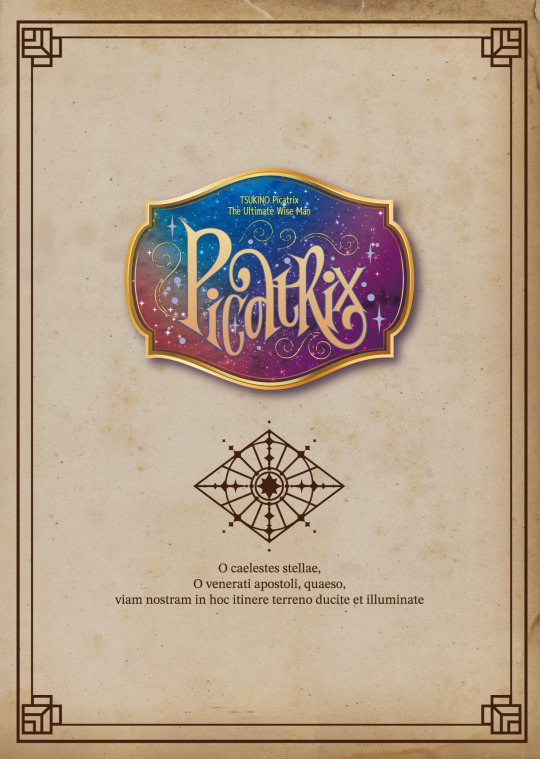#picatrix
Explore tagged Tumblr posts
Text
How to Become an Evil Wizard in the Middle Ages: The Secrets of Picatrix

Could you learn magic and become a powerful and evil wizard? In the Middle Ages, you could—if you had a copy of Picatrix.
Read here
43 notes
·
View notes
Text

"The image of Saturn, according to the opinion of the wise Picatrix, is the shape of a man with a crow-like face and the feet of a camel, sitting upon a throne, with a spear in his right hand and a lance or dart in his left."
Picatrix Bk II, Ch 10 Para 11
49 notes
·
View notes
Text
"It is obvious that all sages agree on this: the planets have influences and powers in this world, through which everything in it exists and is altered by the motions of the planets through the zodiacal signs. Thus, they believed that the root of magic is the motion of the planets." - Picatrix: A Medieval Treatise on Astral Magic (Magic in History) translated by Dan Attrell
17 notes
·
View notes
Text

So I have been hearing a lot about this book for a while now, and It keeps popping up referenced in the research that I have been doing for other workings. So I decided that I would pick up a copy, and it just arrived today. I'm excited to start work on this text.
Shockingly, I was totally unaware of this text until recently. Which I guess isn't to much of a surprise because I don't tend to focus to must on Astrology. While my work tends to pay close attention to Astronomically significant events, I seldom delve into the realm of Astrology.
However recently Astrology continues to be a very central reoccurring theme that has been popping up in many spaces for me. While I don't consider myself to be an overly superstitious person even I can't help pull on the common thread dangling right in front of my face. So I guess I will be beginning my foray into Astrology and it seems that it will start with The Picatrix.
If anyone has read this text and has pointers or an opinion about the work please share with me, either in the comments on this post or you can DM if you like.
Ut fiat!
#occult#witchcraft#magick#occult art#witches of tumblr#spellcraft#spells#witchblr#spellwork#witch community#occult blog#occult manuscript#occultism#witch#witches#spell#occult community#witch craft#witchcore#scarlet witch#witchy vibes#witch coven#astrology#astronomy#astro community#picatrix
12 notes
·
View notes
Text
A Picatrix Decan Talisman Ritual – Arnemancy
7 notes
·
View notes
Text
Discursos de Magia Islâmica
Enquanto Sidi Muhammad enraíza as ciências do invisível na história sagrada islâmica, as raízes históricas desse discurso remontam à Grécia antiga. E enquanto o termo “magia”, como foi definido no século XX por estudiosos de estudos religiosos, tem sido amplamente criticado, estudiosos do Mediterrâneo antigo e tardo-antigo reconstruíram uma história muito antiga da própria palavra. Kimberly Stratton, em particular, focou na produção e desenvolvimento da magia como um discurso de alteridade que visava a “outras” populações específicas enquanto impunha normas de gênero e conformidade sexual. No entanto, além dos discursos da elite, evidências materiais abundantes indicam que os greco-romanos antigos e tardo-antigos de fato se envolveram em algumas das práticas que as elites rotulavam de “magia” (mageia), criando maldições vinculativas (katadesmoi, defixiones) que depositavam em sepulturas, poços e encruzilhadas. Uma abundância de textos do século V a.C. ao século II d.C., chamados coletivamente de papiros mágicos gregos, contêm instruções e receitas para a produção de maldições e poções. Além disso, Bernd-Christian Otto apontou que alguns desses artefatos materiais indicam que os praticantes que os produziram identificaram sua própria prática como “magia”. Desde então, Otto postulou a existência de uma tradição ritual textual heterogênea, mas contínua, de “magia aprendida ocidental” do período grego até o presente. Esse “discurso de inclusão” mágico extrai sua potência e apelo do “discurso de exclusão” mantido pelas elites, e as duas tradições, portanto, se desenvolveram juntas em paralelo.
A palavra sihr em si aparece vinte e três vezes no Quran, particularmente durante o encontro entre Moisés e os feiticeiros do Faraó (Quran 7:112–26, 10:76–81, 20:57–76, 26:37–51) e em um versículo que registra como alguns mequenses acusaram Maomé de ser um poeta, um louco ou um feiticeiro (51:52). Em um versículo, os demônios descrentes (shayātīn) são descritos como tentando as pessoas ensinando-lhes feitiçaria (2:102). E embora o próprio Quran não condene sihr (embora o apresente como uma falsidade), há vários hadīth que pedem a morte de feiticeiros. No entanto, apesar dessa representação negativa de sihr no Quran e no hadith, os estudiosos mostraram que, no período ʿAbbāsid, os muçulmanos passaram a ler o termo por meio de novos estudos produzidos durante o movimento de tradução grega, o esforço multigeracional, patrocinado pelos califas ʿAbbāsid, para traduzir as obras recebidas dos gregos antigos para o árabe. A absorção dessas obras clássicas levou, em última análise, à produção de uma síntese de cosmologias e metafísicas neoplatônicas, neopitagóricas e aristotélicas. As contribuições para essa síntese filosófica e metafísica incluem as obras influentes de Abū Maʿshar (m. 886) sobre astronomia, que descreveram os efeitos causais das rotações planetárias no mundo físico e no corpo humano. Enquanto isso, seu contemporâneo e mentor, al-Kindī (m. 873), identificou esse agente causal da mudança material como os raios astrais emitidos por cada corpo celeste. Al-Kindī descreveu sihr legalmente permitido como atos que extraíam e controlavam o poder desses raios astrais. Uma obra pseudo-aristotélica do mesmo período contém um capítulo intitulado “Sirr al-asrār” (O Segredo dos Segredos), que resume as teorias de influência astral delineadas por Abū Maʿshar e al-Kindī e adiciona instruções para operacionalizar esse conhecimento na prática. Finalmente, o século X viu a produção do compêndio enciclopédico conhecido como Rasāʾil Ikhwān al-Safāʾ (As Epístolas dos Irmãos da Pureza) e o Ghāyat al-hakīm (O Objetivo do Sábio), por Maslama ibn Qurtubī (m. 964). Composto por um grupo enigmático de estudiosos devotados ao conhecimento esotérico, o Rasāʾil situa a prática de sihr como a culminância do aprendizado humano dentro do currículo aristotélico/neoplatônico e localiza o efeito causal dos corpos celestes em seus espíritos celestiais (rūhāniyyāt), para os quais eles fornecem nomes e invocações. De acordo com os Irmãos, esses seres espirituais afetam o mundo material por meio de suas correspondências com naturezas materiais ou "por meio de suas almas e volição". Enquanto isso, o Ghāyat "expande e sistematiza" tanto as teorias de causalidade encontradas nas obras de Ab�� Maʿshar e al-Kindī quanto as aplicações práticas apresentadas no "Sirr al-asrā r".
Sorcery or Science?: Contesting Knowledge and Practice in West African Sufi Texts - Ariela Marcus-Sells
6 notes
·
View notes
Text
just treated myself to one of the newer translations of the Picatrix!
the other versions were hard to get through so hopefully this one is a bit more user friendly.
5 notes
·
View notes
Text
PICATRIX VISUALS

☆ TSUKINO PICATRIX ☆
O caelestes stellae, O venerati apostoli, quaeso, viam nostram in hoc itinere terreno ducite et illuminate
#TsukiPika #AGF2023

☆ TSUKINO PICATRIX ☆
【Six Gravity】 Shiwasu Kakeru 「 The Caravan 『Gravity』 is here! Please stop by and have a look! We have rare items from all over the world! ...Eh? My horn? Hmmm~ it's an accessory☆ 」
#TsukiPika #AGF2023

☆ TSUKINO PICATRIX ☆
【Six Gravity】 Kisaragi Koi 「 Yes, yes, yes! Count on 『Gravity』 to solve your problems! Even magic-related problems will be solved in a bli--wait, uhh, WOAHHHH!? 」
#TsukiPika #AGF2023

☆ TSUKINO PICATRIX ☆
【Six Gravity】 Uduki Arata 「 Hehehe, do not underestimate this Black Panther of the Desert (self-proclaimed)... meow」
#TsukiPika #AGF2023

☆ TSUKINO PICATRIX ☆
【Six Gravity】 Satsuki Aoi 「 Only Haru-san and I are members of the Magic Confederation. We get along with them well, from a reasonable distance. Our policy is to travel freely without being tied down. 」
#TsukiPika #AGF2023

☆ TSUKINO PICATRIX ☆
【Six Gravity】 Yayoi Haru 「 For an orphan from the slums to acquire so much money and power.. Hajime, I'm glad I bet on you. Ah, don't worry. Leave all the trivial matters to me♪ 」
#TsukiPika #AGF2023

☆ TSUKINO PICATRIX ☆
【Six Gravity】 Mutsuki Hajime 「 Travelling is nice. I get to meet various people, and get to experience many things. I want to see more and more skies. 」
#TsukiPika #AGF2023

☆ TSUKINO PICATRIX ☆
(Image on text: Hajime's tummy. Hajime's tummy. Hajime's tummy.) SHUN: I'm~ sorry~. The moon has called for me, so I shall see you later~! IKU: Your eyes can't hide your desire (lol)
#TsukiPika #AGF2023

☆ TSUKINO PICATRIX ☆
【Procellarum】 Minaduki Rui 「 Fuhahaha. I am an apostle of Pluto and one of the 『Sanctus』, who rule over the death and End. 」
#TsukiPika #AGF2023

☆ TSUKINO PICATRIX ☆
【Procellarum】 Kannaduki Iku 「 I was, once, someone who could not use magic... but after one morning, I woke up with the protection of Pluto and I, on the Demon King's lap. I don't think you will understand what I am talking about. I still don't understand either. 」
#TsukiPika #AGF2023

☆ TSUKINO PICATRIX ☆
【Procellarum】 Haduki You 「 Too bad, uncle~! It's been decided that that item was mine, since I was born. So~ choose between running away or being forced to run. Which will it be? 」
#TsukiPika #AGF2023

☆ TSUKINO PICATRIX ☆
【Procellarum】 Nagatsuki Yoru 「 Fwaaah!? I-I'm sorry!!! Uhm, that, are you okay?! What you just touched was... a cursed pendulum that was full of my... energy... Aaaah, I'm sorry!!! 」
#TsukiPika #AGF2023

☆ TSUKINO PICATRIX ☆
【Procellarum】 Fuduki Kai 「 My bad, my guys are a bit too noisy (wry smile). Hm? Me? I... Even since I was given the flesh and blood of the White Demon King, I may have become slightly more than just a human. Maybe?? 」
#TsukiPika #AGF2023

☆ TSUKINO PICATRIX ☆
【Procellarum】 Shimotsuki Shun 「 How far is a human's child willing to go? Show me? Play with me? Dance with me until the end! Ahahahahaha! 」
#TsukiPika #AGF2023
>MORE INFO
HARU: It was a little hard to understand, so let me clarify. Hajime started out an orphan from the slums. I am the young master of a rich family♪ My father invested in Hajime while I helped out. Hajime ended up becoming someone who has far more financial power than my own family. Hehe, to raise to the top with one's own ability... it's fun, isn't it?
#TsukiPika
#tsukiuta#tsukiuta twitter#cielotranslations#procellarum#six gravity#mutsuki hajime#shimotsuki shun#fuduki kai#yayoi haru#haduki you#nagatsuki yoru#satsuki aoi#uduki arata#minaduki rui#kannaduki iku#kisaragi koi#shiwasu kakeru#picatrix#agf 2023#tsukipica
40 notes
·
View notes
Text
Dan Attrell and David Porreca, translators. Picatrix: A Medieval Treatise on Astral Magic, Magic in History Series. The Pennsylvania State University Press, 2019. Hardcover edition. 372 pages.
Shop link in bio.
instagram
3 notes
·
View notes
Text
As a practicing witch and general occultist for well over two decades, I see these kinds of correspondences and wonder at their source. Sometime ago I began to wonder where exactly the ideas, associations, and correspondences between various herbs and their effects came from. I'd accepted the general consensus from any number of texts, but never once read where they came from. Thus began my journey as a true occultist, in my humble opinion.
I began to read any and every text of old on the subjects of magic, witchcraft, paganism, shamanism, religion, spirituality, etc etc. It was a fascinating journey, and one that I would suggest to any practicing witch or just someone who was interested in such stuff. I will provide a list of interesting texts below. You never know what little bit of lore you may find and add to your own practice! I can confidently say that my own practice is hardly recognizable when compared to what it was before.
All of this to say, I see this post about the different types and uses of water, and I wonder where the author got their ideas from. (Let me be clear, I'm not throwing any judgement at them, nor do I question the authenticity of it. In fact, I actually love this idea, and plan on using it myself.) Did they come up with this on their own? Who knows. Is it from some text of old? Could be. Does it really matter, as long as it works for whomever uses it? Not at all.
I've lost my way with my train of thought on what I was leading up to. Or perhaps, there was no point, and I was simply vomiting words onto the page. Such is life.
Anyway, some really good books of old that I suggest:
Greek Magical Papyri
The Picatrix
The Keys of Solomon
Natural Magick by John Baptista Porta
By no means an exhaustive list, but there's some quite interesting ideas to be found withing. Also, on the subject of books, Drawing Down The Moon is a fantastic anthropological study on the resurgence of Paganism. I cannot recommend it enough.
I will remove myself from the soap box now. <3
~ Abadon
Different types of water and their magickal uses:

Sea water: good for curse/hex breaking, cleansing, healing, banishing and protection spells.
Dew water: beauty, love and fertility spells, as well as delicate magick. Also Good for Fae work.
Storm water: is great for spells and rituals that has to do with emotional strength, confidence, charge, motivation and force. It’s known for strengthening spells. Also good for curses.
Snow water: Spells and rituals that focus on purity, endings and change, as well as slow working spells.
River water: Good for creating changes, moving on and letting go of negativity, warding and focusing energy.
Rain water: Very multi-purpose, but specifically great for growth and rebirth spells. Great for spells that you want to keep gaining power over time.
Spring water: Growth, holy water, cleansing, protection, prosperity
Moon water: Depending on the moon phase it was created in, it can have different properties.
Sun Water: protection, healing, clairvoyance, courage, strength, prosperity, luck, self-love, cleansing and creativity.
Swamp Water: Used for banishing and binding.
tip-jar
#saving this one for later too#paganism#nature#pagan#spilt thoughts#greek magical papyri#picatrix#drawing down the moon#keys of solomon#natural magic
5K notes
·
View notes
Text


Prayer beads made with my Picatrix Image of Venus talisman cast in shibuichi (a 3:1 copper:silver art metal alloy), with seven sets of seven lapis lazuli beads and eight copper spacer beads strung on copper wire with blue silk tassels.
The talismanic image of Venus is derived from the Picatrix, a Renaissance-era grimoire translated from its original Arabic, first to Spanish, then to Latin, and now to English: "...the shape of a woman with a human body but with the head of a bird and the feet of an eagle, holding an apple in her right hand and a wooden comb similar to a tablet in her left, which has these figures written upon in [the Greek letters OLOIOL]. Whoever carries this image will be well received and esteemed by all." (Picatrix Bk 2, Chapter 10, Paragraph 55, translated by Attrell and Porecca)
The back of the talisman bears the Grand Planetary Seal of Venus and the Characters of Venus according to Agrippa.
The talisman is made from shibuichi and the beads are lapis and copper. Other materials may be available as custom orders. Please contact me directly.
Each piece is hand-made to order in my home studio, with unique variations and defects as a result of the fabrication and casting process.
These talismans are NOT consecrated. That is your responsibility.
Astrological timing and consecration is available with a minimum of 30 days advance notice at an additional charge depending on the difficulty of the election.
#Occult Art#Talismanic Jewelry#Picatrix#Venus#Image Of Venus#Witchcraft#Witch Jewelry#Pagan#Jewelry#Art Jewelry#Jewelry Art#Queer Artist#Queer Jeweler#LGBT#Sorcerers Workbench
19 notes
·
View notes
Text

0 notes
Text
#occult#islamicesotericism#rejectedreligionpodcast#patreon#perennialism#traditionalism#healing#picatrix#magic#illuminatingtheobscure
0 notes
Text
A bit about my rosarium lunae practice from yesterday:
I decided to wear my consecrated first pentacle of the Moon while doing the recitations, and did so for the first time. I was in a wakeful state of mind and pronounced the evocations from memory.
I think the third point might be more relevant than I was initially considering: the recitations should be done either with the eyes closed or in a meditative and receptive state - as in not being read - , not forcing any vision but paying attention to the images that arrive. Alternatively, I think reflecting on the qualities of the mansion (elemental/fortunateness) might allow the mind to grasp what the spirit might be trying to communicate, so to speak.
For the beginner set of practices Maria Miles recommends visualizing one of the images of the Moon, but I think mantaining the vision in one's mind eye shouldn't be the goal if one is aiming for communion with the mansion's spirit. That is, I would start the practice by visualizing one of the standard moon images, and then gradually let my mind perceive the form the spirit wants to take.
Thus I'd say I was able to get a meaningful vision during my meditation with the 8th mansion spirit. Typically the name given for the mansion (Al-Nathrah) is "the Gap", but Miles assigns to it the title of "the Nose Tip" - which isn't wrong since it was associated with the nose of Leo in arabic astrology. Al-Nathrah is also given a cold and mixed quality - in this respect the spirit appeared to me as a snow-lion/ess beside an icy mountain, and I got the impression that it was female. I felt compelled to salute it at the end.
Afterwards I returned to Warnock's Mansions of the Moon to check what image and attribute the Picatrix assigns to Al-Nathra. Interestingly the talismanic image is of an eagle with the head of a man (I remember the Attrell edition inverts the man/eagle thing) by a mountain cliff. The talismanic quality is for victory. So I guess I'm inclined to conclude this mansion can be associated with mountains and can be thought of as a combination of some Cancer attributes (coldness, water, 'femininity') with Leo ones (victory and... big cats).
1 note
·
View note
Text
Livy • she/her • 21 • New York
Salvete, nice to meet you! I’m Livy, and I’m a lover of the medieval period and an aspiring academic based in New York. I’m a fan of Thomas Aquinas, Dante, Franciscans, Zara Yaeqob, the Picatrix, Joachim of Fiore, The Kěbra Nagast, Polyphemos, and Shakespeare.
Feel welcome to say hi! :)
2 notes
·
View notes
Text
'Magia' no Islam
Publicações recentes de acadêmicos em estudos islâmicos esclareceram o esboço do crescimento e disseminação de discursos inclusivos de magia islâmica no início do período medieval. Esses estudos demonstram que o termo árabe sihr serviu às mesmas funções discursivas no mundo arábico pré-moderno que o termo “magia” serviu nos contextos grego e latino. Os primeiros textos escritos de praticantes de sihr/magia autoidentificados foram produzidos durante os séculos IX e X, mesmo quando teólogos e sufis debatiam a existência e a legitimidade dos charismata. Essas obras incluíam as cartas dos enigmáticos Irmãos da Pureza (Ikhwan al-Safa) e o Ghāyat al-hakīm (O Objetivo do Sábio), atribuído a Maslama ibn Qā sim al-Qurtubī (m. 964). As obras em língua árabe sobre magia astral sintetizaram entendimentos neoplatônicos sobre a relação entre almas individuais e a “Alma do Mundo”, ideias aristotélicas de causalidade e uma matematização neopitagórica do cosmos.
Nos séculos XII e XIII, os estudiosos muçulmanos que escreviam em árabe eram muito menos propensos a descrever suas próprias obras como sihr, pois as discussões sobre esse termo mudaram para um discurso de exclusão. No entanto, esse período também viu a elaboração de uma “ciência de nomes e letras” por escritores sufis, que postularam uma cosmologia letrista pela qual os nomes de Deus e as letras que compunham esses nomes correspondiam tanto a números quanto a propriedades e componentes específicos do universo. Filósofos sufis renomados, como Ibn al-ʿArabī, discutiam as ciências de nomes e letras e ocasionalmente mencionavam suas aplicações taumatúrgicas, particularmente na construção de talismãs. A articulação dos aspectos teóricos e aplicados desta ciência alcançou uma formulação decisiva nas obras de Ahmad al-Būnī (m. ca. 1232). O histórico al-Būnī foi um filósofo e professor sufi que desenvolveu círculos de leitura esotérica no Cairo. Suas obras se concentraram na elaboração de uma cosmologia sufi neoplatônica na qual os nomes de Deus e as letras servem como agentes da criação e na aplicação prática desses nomes e letras para atingir tanto os mistérios divinos quanto os benefícios deste mundo. A reputação de Al-Būnī tornou-se associada quase inteiramente à aplicação prática das ciências e resultou na proliferação de falsificações e imitações textuais atribuídas a ele após sua morte.
O mais importante deles, o Shams al-maʿārif al-kubrā (Os Sóis do Conhecimento: A Versão Mais Longa), foi produzido no século XVII e alcançou amplo apelo no Norte da África e no Oriente Médio. O Shams al-maʿārif al-kubrā e outras obras pseudo-būnianas eventualmente adquiriram uma reputação como obras de sihr, e foi por meio da circulação de textos como esses que os discursos mágicos se tornaram profundamente associados ao reino do sufismo.
Os estudiosos também rastrearam a transmissão de discursos mágicos islâmicos para a Europa Ocidental. Liana Saif, em particular, demonstrou como a tradução de textos árabes sobre magia astral para o latim nos séculos XI e XII estimulou o crescimento da “filosofia oculta” ocidental nos séculos XV e XVI. A filosofia oculta de mágicos renascentistas como Marsilio Ficino, Giovanni Pico e John Dee “apresentou essa ‘magia natural’ como parte de uma única e suprema tradição de sabedoria religiosa derivada de sábios como Zoroastro ou Hermes Trismegisto”. Essa “filosofia oculta” da Renascença então se tornou a “cesta de lixo” da magia rejeitada e da superstição do Iluminismo. No entanto, mesmo quando novas categorias de “ciência” e “religião” ganharam coerência na Europa moderna, um contramovimento que rejeitou o “racionalismo filosófico e a filosofia mecânica” do Iluminismo resultou no surgimento de um novo conjunto de “ciências esotéricas” ou “ocultas”. Este período viu uma ampla gama de grupos combinarem “um impulso para recuperar um Deus oculto” com tentativas de estabelecer um estudo científico do reino espiritual. Ao contrário das ciências ocultas do Renascimento, esses movimentos se basearam em concepções da era do Iluminismo de um processo racional e científico, mesmo quando tentavam reposicionar o espiritual dentro do científico. A partir desses desenvolvimentos da Europa Ocidental, acadêmicos como Peter Pels concluíram que “a magia pertence ao moderno”, porque “os discursos modernos posicionaram a magia como sua antítese, reinventando-a no processo”. Bever e Styers descreveram esse processo como um “gesto duplo”, no qual as tentativas de banir e deslegitimar o discurso mágico apenas reforçam e reinscrevem a magia como um “recurso potente” alternativo. As discussões europeias e norte-americanas sobre magia nos séculos XIX e XX envolveram claramente a reconceitualização de discursos mágicos herdados do passado e o reposicionamento deles em relação a forças como industrialização, educação, consumismo e novas mídias, entre outras. No entanto, o “duplo gesto” de Bever e Styers descreve essencialmente um processo pelo qual as elites tentam reivindicar autoridade sobre uma esfera de conhecimento legítimo, ao mesmo tempo em que invalidam e marginalizam as tradições textuais-rituais de vários outros marginalizados. Esse processo básico também descreve os discursos mágicos gêmeos de exclusão e inclusão descritos por Otto — o processo de definir e categorizar um corpo “rejeitado” de conhecimento e prática ironicamente abre essa esfera para uma poderosa reinterpretação e reapropriação.
Sorcery or Science?: Contesting Knowledge and Practice in West African Sufi Texts - Ariela Marcus-Sells
#islam#magia#socdrel#traducao-en-pt#cctranslations#sorceryorscience-AMS#sihr#charismata#sufi#irmãos da pureza#picatrix#ahmad al-buni#shams al-ma'arif
2 notes
·
View notes